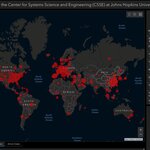Immunology

Science is often easy in hindsight and two years from now we will likely know the evolution of SARS-CoV-2 from bats to humans. For now, it is mostly speculation.
An intermediate animal host may have been snakes or pangolins, but the real common ancestor of SARS-CoV-2 goes back for as long as coronavirus was recognized as distinct from the common cold - the 1960s.
A recent analysis links SARS-CoV-2, the official name for the 2019 coronavirus that can cause the COVID-19 disease, to dog intestines. There is no secret that Wuhan's wet markets - disgusting confluences of feces, urine, and…

Wealthy elites from Manhattan have been retreating to their vacation homes while year-round residents wish they would stay away. Urban residents are being treated look poor refugees during pandemics, famine, and war. They will bring the problem with them, it is believed.
While it may seem like an odd stance for progressive elites in the northeast to take about their fellow man, it is likely the first time that these issues were anything except academic to them. And they are not wrong for believing that people from cities are more likely to be carriers.
But while cities are more likely…

There is no question that travel restrictions and social distancing have helped reduce the spread of SARS-CoV-2, that coronavirus strain that originated in Wuhan, China late last year and then spread worldwide.
What about quarantine?
A new review hopes to shed some light but because the review is primary of modeling papers - many of which looked like estimates and some more like guestimates - it may be only partially useful from an applied health policy perspective. The real answers may not be known for years.
With no vaccines and proposed medicines only now going into clinical trials, some U…

The U.S. Food and Drug Administration continue to be the kind of nimble agency it once was in response to the SARS-CoV-2 coronavirus pandemic, and the hundreds of U.S. deaths COVID-19 has caused.
They are not only facilitating access to antibody-rich plasma donated by people who have recovered from COVID-19, in hopes transfusions could lessen the severity or duration of the illness, they have gone a step further and are helping create a master protocol so independent investigators can work on this without the usual 'I won't share data in case I get beat to publication' concern that besets the…

Public health officials consistently promote hand-washing as a way for people to protect themselves from the COVID-19 coronavirus. However, this virus can live on metal and plastic for days, so simply adjusting your eyeglasses with unwashed hands may be enough to infect yourself. Thus, the Centers for Disease Control and Prevention and the World Health Organization have been telling people to stop touching their faces.
We are experts in psychological science and public health. Brian Labus is an expert in communicable diseases who knows what people should do to avoid becoming infected.…

The 2019 version of the coronavirus that has spread to about 50 countries across the world doesn't appear to be transmittable from pregnant mothers to newborns at birth. The new case study is the second out of China within the last month to confirm that mothers infected with coronavirus disease 2019 (COVID-19) during pregnancy did not infect their babies.
All four mothers in the current study gave birth at Wuhan's Union Hospital while infected. Wuhan in Hubei Province was the epicenter of the current outbreak that has sickened more than 100,000 people worldwide and killed more than 3,400,…

Though COVID-19 as a disease is rather difficult to get, spreading the coronavirus itself is as easy as spreading influenza viruses. The big risks will be from a sneeze, though COVID-19 doesn't have much sneezing, or a cough, or touching someone's hands who did either and then touching your own face.
Why do people subconsciously touch their face if they felt something weird on their hands? That is a mystery of psychology, but it's why that is the best deterrent to catching coronavirus or spreading it.
Yet if someone sneezes and you don't touch their hand, how long will the virus in its…

On January 23, 2020, Illinois reported the state's first laboratory-confirmed case (index case) of severe acute respiratory syndrome coronavirus 2 (SARS-CoV-2), which causes COVID-19, in a woman in her 60s who had returned from Wuhan, China in mid-January. Subsequently, the first evidence of secondary transmission in the USA was reported on January 30, when her husband, who had not traveled outside the USA but who does suffer from chronic obstructive pulmonary disease (COPD) and chronic cough, had frequent, close contact with his wife since her return and while she was symptomatic…

A new paper has identified the risk factors for death from COVID-19, also called coronavirus and Wuhan flu, and they are much like any other flu; being older and having pre-existing conditions are the biggest concerns.
The results are observational from 191 patients and only from two hospitals in Wuhan, China, so caution is warranted when interpreting them even more than with other epidemiological correlation, but along with age showing signs of sepsis, chronic respiratory illness, and having blood clotting issues when admitted to hospital are unsurprisingly the key risk factors…

Smallpox was wiped out by using mathematical containment rings coupled with vaccines and it makes sense that one way to contain an infectious disease outbreak is to limit travel.
Unless travel bans are only bans for some people. In communist China, elites are still going on vacation, they are still traveling for business, they are still going to foreign colleges. The novel coronavirus in Wuhan, China, now known as COVID-19, has infected tens of thousands and killing hundreds while spreading to at least 24 other countries. That led many governments, including the United States, to restrict…